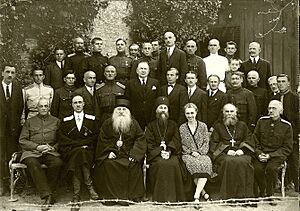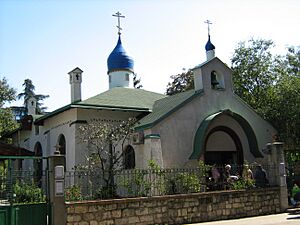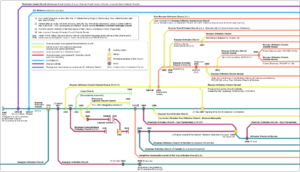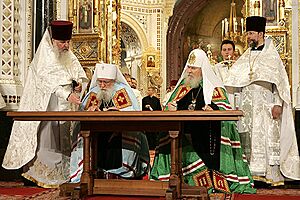Russian Orthodox Church Outside of Russia facts for kids
Quick facts for kids Russian Orthodox Church Outside of RussiaРу́сская Правосла́вная Це́рковь Заграни́цей |
|
|---|---|

ROCOR headquarters,
75 E 93rd St, New York. |
|
| Abbreviation | ROCOR |
| Classification | Eastern Orthodox |
| Primate | Patriarch of Moscow & All Rus' Kirill |
| First Hierarch | Metropolitan Nicholas (Olhovsky) |
| Language | Church Slavonic (worship), Russian (preaching), English (USA, Canada, UK, Ireland, Australia, New Zealand), Spanish (Spain and Latin America), German (Germany, Austria), French (France, Switzerland, Canada), Haitian Creole (Haiti), Portuguese (Portugal and Brazil), Italian (Italy) and others |
| Headquarters | New York City, NY |
| Territory | Americas Europe Australia New Zealand |
| Founder | Anthony (Khrapovitsky) Anastasius (Gribanovsky) Eulogius (Georgiyevsky) |
| Independence | 1920 |
| Reunion | 2007 |
| Recognition | Self-government church within Russian Orthodox Church |
| Separations | Archdiocese of Russian Orthodox Churches in Western Europe (since 1926–1927), Northern American Metropolia (1927–1934 and since 1946, now Orthodox Church in America), Holy Orthodox Church in North America (since 1986), Russian Orthodox Free Church (since 1994–1995; now Russian Orthodox Autonomous Church), Russian Orthodox Church in Exile (since 2001), Russian True Orthodox Church (since 2001) Slavic Orthodox Vicariate of America (since 2019) |
| Members | 27,700 in the U.S. (9,000 regular church attendees) |
The Russian Orthodox Church Outside of Russia (ROCOR), also known as the Russian Orthodox Church Abroad, is a special part of the larger Russian Orthodox Church. It is like a self-governing branch. Currently, Metropolitan Nicholas (Olhovsky) is its main leader.
ROCOR started in the early 1920s. It became independent because many bishops and followers left Russia after the Russian Civil War. They moved to places like Paris, the United States, and other Western countries. These bishops did not agree with the Moscow Patriarchate's strong support for the Bolshevik government in the USSR. Metropolitan Anthony (Khrapovitsky) was the first main leader of ROCOR.
After being separate for about 80 years, ROCOR and the Moscow Patriarchate officially reunited on May 17, 2007. They signed an agreement called the Act of Canonical Communion with the Moscow Patriarchate.
Today, ROCOR has about 400 churches around the world. It has over 400,000 members. In the United States alone, there are 232 churches and 10 monasteries. ROCOR has leaders called hierarchs and monasteries for both men and women in many countries.
Contents
A Look at ROCOR's Past
How It Began
During the Russian Civil War in 1919, some Russian bishops formed a church group in southern Russia. This was because they couldn't easily connect with the main church leaders in Moscow. In November 1920, the head of the Russian Church, Patriarch Tikhon, gave permission for bishops to organize themselves if they were cut off from Moscow. This rule helped create the independent church group that became ROCOR.
Later in 1920, many Russian bishops left Russia and went to Constantinople (now Istanbul). They decided to keep their church organization separate while they were abroad. They formed a temporary church administration.
Life in Serbia
In 1921, Metropolitan Antony (Khrapovitsky) settled in Sremski Karlovci, Serbia. Other bishops, priests, and monks also moved there. The Serbian Church recognized their group as an independent church for Russians living outside Yugoslavia.

In late 1921, a big meeting of Russian Church representatives from abroad took place in Sremski Karlovci. This meeting was later called the "First All-Diaspora Council." They created a "Supreme Ecclesiastic Administration Abroad" (SEAA). The council also made some political statements. They hoped to bring back the monarchy in Russia with a tsar from the House of Romanov. They also asked world leaders to help remove the Bolshevik government from Russia.
However, Patriarch Tikhon in Moscow did not agree with these political statements. In 1922, he ended the SEAA. In its place, the bishops formed the Temporary Holy Synod of Bishops of the Russian Orthodox Church Outside Russia. Metropolitan Anthony became its head.
In North America and Western Europe, some bishops did not fully accept the authority of this new Synod. For example, Metropolitan Eulogius (Georgiyevsky) in Paris later joined the Ecumenical Patriarchate of Constantinople.
In 1927, the ROCOR bishops in Serbia decided to formally break ties with the Moscow church leaders. They refused to declare loyalty to the Soviet government. They believed the Moscow church was controlled by the "godless Soviet power." Even though they separated, ROCOR still saw itself as a part of the larger Russian Church.
In 1934, the Moscow Patriarchate suspended Metropolitan Anthony and his Synod. But Metropolitan Anthony did not accept this decision, saying it was made under Soviet pressure. The Patriarch of Serbia, Varnava, supported ROCOR.
Metropolitan Anthony passed away in 1936. Anastasius (Gribanovsky) became the new leader. In 1938, the Second All-Diaspora Council was held. It confirmed the Church's role in Russian groups living abroad.
During World War II
During World War II, the relationship between ROCOR and the Nazis was complex. Metropolitan Anastassy wrote a letter to Adolf Hitler in 1938, thanking him for allowing a Russian Orthodox Cathedral to be built in Berlin. Some say this was done when the church leaders knew little about the Nazi government's true nature.
Meanwhile, the Soviet government changed its approach to religion. In 1943, Joseph Stalin allowed the Moscow Patriarchate to elect a new Patriarch and reopen some churches. However, ROCOR leaders still refused to recognize the Moscow Patriarchate, believing it was controlled by the Soviet government.
In 1944, as the Red Army advanced, Metropolitan Anastasius and other bishops left Serbia. They eventually moved to the United States in 1950, along with many other Russian Orthodox refugees.
After the war, the Moscow Patriarchate became the main branch of Russian Orthodoxy globally. Many ROCOR churches and clergy in countries now under Soviet influence joined the Moscow Patriarchate. However, ROCOR, based in New York, continued to reject both the Soviet government and the Moscow Patriarchate. They saw the Moscow Patriarchate as being influenced by the Soviet secret police.
For a long time after World War II, most Orthodox Church properties in Palestine were controlled by ROCOR. But when Israel became a state in 1948, it transferred some of these properties to the Moscow-led Russian Orthodox Church.
The Cold War Years
Philaret (Voznesensky) became the third main leader of ROCOR in 1964 and served until 1985.
ROCOR always believed that the Soviet government was manipulating the Moscow Patriarchate. They felt that because of this, they could not have official ties. ROCOR always stated that it was a part of the Russian Church, but its independent status was temporary. This independence would last until the atheist government in Russia no longer controlled the Church.
Metropolitan Anastassy (Gribanovsky) wrote that as long as the Moscow Patriarchate worked closely with the Soviet government, ROCOR should not have any official connection with them.
The "Catacomb Church" was a group of believers who went underground in Russia to avoid Soviet persecution. Most ROCOR members were Russians who left Russia before World War II. They did not know that many in the Catacomb Church had reconciled with the Moscow Patriarchate after 1945. By the 1970s, very little of the Catacomb Church remained.
Vitaly (Ustinov) served as the fourth main leader from 1985 until 2001. After the Soviet Union ended in 1991, ROCOR remained separate from the Moscow Patriarchate. ROCOR even started new churches inside Russia.
After the Soviet Union
In 1997, Patriarch Alexei II of Moscow tried to visit a ROCOR monastery in Hebron. ROCOR clergy refused to let him in, saying he had no real authority. Later, local police helped transfer the property to the Moscow-led church.
Metropolitan Laurus (Škurla) became the fifth main leader of ROCOR in 2001. He was interested in reuniting with the Russian Orthodox Church. ROCOR wanted the Moscow Patriarchate to address the killing of Tsar Nicholas II and his family in 1918. They also worried about the Moscow Patriarchate's ties with other Christian groups.
In 2000, the Russian Orthodox Church officially recognized Tsar Nicholas and his family as saints. They also stated that the Church should not be overly obedient to secular authorities and rejected connections with Catholicism.
A Small Split (ROCOR(V))
The idea of reuniting caused a small split in ROCOR in 2001. Metropolitan Vitaly (Ustinov) retired, but then said he was still the leader. Some clergy and members who opposed reunification formed a new group called "Russian Orthodox Church in Exile," also known as ROCOR-Vitaly or ROCOR(V).
The main ROCOR leaders said that Metropolitan Vitaly was being influenced by others because of his poor health. They claimed his signature was forged on documents.
Steps Towards Unity
In 2003, Russian President Vladimir Putin met with Metropolitan Laurus in New York. In 2004, Metropolitan Laurus visited Russia and participated in joint services. Later, ROCOR clergy met with Patriarch Alexei II.
After several meetings, ROCOR and the Moscow Patriarchate announced in 2005 that they were close to fully restoring their relationship. ROCOR would keep its independent status. Patriarch Alexei said ROCOR would keep its property and financial independence.
In 2006, ROCOR agreed to the "Act of Canonical Communion." This document outlined how the churches would reunite.
Signing the Unity Agreement
On May 17, 2007, the Act of Canonical Communion was officially signed. This restored full unity between the churches. A special church service was held at the Cathedral of Christ the Saviour in Moscow. Patriarch Alexei II and Metropolitan Laurus led the service together for the first time.
During the ceremony, the Act was read aloud and signed by both leaders. They exchanged a "kiss of peace" and the church sang "God Grant You Many Years." All the bishops from both churches shared in the Eucharist.
Russian President Vladimir Putin was present and thanked for helping the reunification. He said that the church split was caused by a deep political split in Russian society. He added that restoring church unity helps Russia's national revival.
The ROCOR leaders also served with the Patriarch on May 19, 2007, at the consecration of the Church of the New Martyrs in Butovo firing range. They had laid the first stone for this church in 2004.
President Vladimir Putin held a reception at the Kremlin to celebrate the reunification. Many important church and government officials attended.
Another Small Split (ROCA-PSCA)
After the Act of Canonical Communion was signed in 2007, there was another small split in ROCOR. Some critics still felt that the Moscow church leaders had not fully addressed the issue of government influence during the Soviet period.
One Ukrainian priest, Metropolitan Mikhail "Agathangel" Ivanovich Pashkovsky, and some churches in Ukraine refused to join the Moscow Patriarchate's Ukrainian branch. Agathangel was suspended by ROCOR leaders. However, he continued with the support of some churches and formed a new group called ROCA-PSCA or ROCOR-Agathangel.
How ROCOR Is Organized
ROCOR is led by the First-Hierarch. This person is the main leader of ROCOR, the head of its Holy Synod, and the bishop of the Russian Orthodox Eparchy of Eastern America and New York. The Holy Synod also has a vice-president. The main decision-making body for ROCOR is the Council of Bishops, which meets about every two years.
ROCOR is divided into different areas called dioceses. These dioceses sometimes have smaller divisions within them.
Here are some of the main dioceses:
- United States:
* Russian Orthodox Eparchy of Eastern America and New York * Diocese of San Francisco and Western America * Diocese of Chicago and Middle America
- Diocese of Montreal and Canada
- Diocese of Caracas and South America
- Russian Orthodox Diocese of Great Britain and Western Europe
- Diocese of Berlin and Germany
- Russian Orthodox Diocese of Sydney, Australia and New Zealand
ROCOR also manages properties of the Russian Ecclesiastical Mission in Jerusalem. These include three monasteries in East Jerusalem and Israel/Palestine.
Money Matters
The main way ROCOR's central office gets money is by leasing part of its headquarters building in New York City to a private school. In 2016, this was estimated to bring in about $500,000. ROCOR does not contribute money to the main Russian Orthodox Church's budget.
Western Rite in ROCOR
ROCOR has a small number of churches that use the "Western Rite." This means they use older Christian worship styles from Western Europe, rather than the usual Eastern Orthodox style. While not many churches use this rite, it has a long history within ROCOR.
For example, the Benedictine Christ the Savior Monastery in Ontario, Canada, uses the Western Rite. There are a few other churches that use it fully or partly. In 2011, ROCOR grouped all its Western Rite churches into a "vicariate."
In 2013, some changes were made to the leadership of the Western Rite vicariate.
Important Churches
- St. Elizabeth's Church, Wiesbaden
- Russian Orthodox Church of the Transfiguration of Christ, Baden-Baden
- Church of Saint Alexandra, Bad Ems
- Church of Saint Sergius of Radonezh, Bad Kissingen
- Russian Chapel, Bad Homburg
- Church of Saint Procopius of Ustyug, Hamburg
- Cathedral of the Nativity of the Most Holy Mother of God and the Holy Royal Martyrs, Chiswick
- Alexander Nevsky Church, Copenhagen
- Russian Church, Geneva
- Russian Orthodox Church, Vevey
- Russian Orthodox Church of Saint Job, Brussels
- St. Peter and Paul Church, Luxembourg
- Alexander Nevsky Cathedral, Howell, New Jersey
- Cathedral of St. John the Baptist (Washington, D.C.)
- St Nicholas Russian Orthodox Cathedral, Brisbane
- Holy Trinity Orthodox Church (Mebane, North Carolina)
More to Explore
- List of bishops of the Russian Orthodox Church Outside Russia
- Eastern Orthodox Church
- White émigré
- Orthodox Church in America
See also
 In Spanish: Iglesia ortodoxa rusa fuera de Rusia para niños
In Spanish: Iglesia ortodoxa rusa fuera de Rusia para niños




